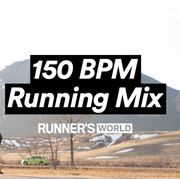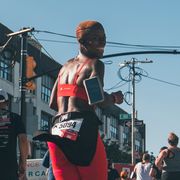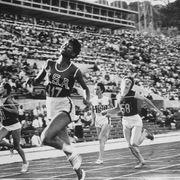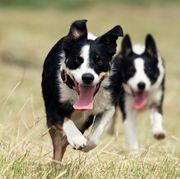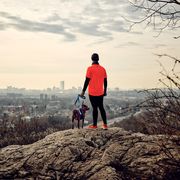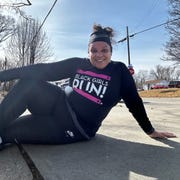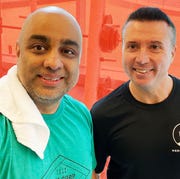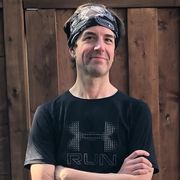Several years before she was diagnosed with runner’s dystonia—a rare neurological condition that creates a feeling of disconnection in one leg—Kara Goucher tried to do a little research about it.
A runner named Justine Galloway had attended one of Goucher’s retreats in 2018. Galloway has runner’s dystonia and runs backward, a creative solution to trick her brain.
“I was like, wait, what?” Goucher told Runner’s World by Zoom this week. “I remember being so impressed, because we ran down the creek path to the [University of Colorado] track, ran a workout, and ran back, and she did the whole thing backward.”
Afterward, Goucher Googled the disease, but couldn’t quite remember the name—runner’s dysmorphia? She hit a dead end, and didn’t think much of it again.
Until last November, when she sat in the office of a neurologist who was certain runner’s dystonia was the cause of her mystifying symptoms. That night, unable to sleep, she searched again.
This time, she turned up research papers and a 2018 Runner’s World article that compiled the stories of runners like Galloway with expert comment on a condition that’s likely much more common than documented.
“At first I was like, I don’t have that, whatever he’s talking about. I’ll just rehab it,” she said. “Reading all those articles, that’s when it started to sink in. A lot of it was similar in ways that are really hard to describe—the onset and the way it makes them feel.”
Three weeks after she revealed her diagnosis on Instagram, Goucher talked more about how her symptoms developed, the emotional toll (“losing running in the way I love it is something I’m struggling to accept,” she wrote in her post), and her hopes for the future.
This interview has been edited for length and clarity.
Runner’s World: How are you doing, today?
Kara Goucher: I’m okay. When I put it on Instagram, I was relieved to have it out there. Then I got overwhelmed by the response and kind of disappeared for a week or so.
But I’m feeling better. I’m feeling hopeful that there are opportunities and options and things to try long term that maybe I can get more of my body back.
You mentioned falling in December of 2020. What happened, and was that the first sign?
That’s the first time I thought anything was wrong. But looking back, when I was training for the 2019 Houston Marathon, my coaches, Mark Wetmore and Heather Burroughs, kept saying, “Your hip is dipping, you need to strengthen that left hip.” I think that’s probably when things were starting.
In fall of 2020, I was catching my left toe a lot when I was out running. I thought, “I’m just tired.”
Then one day toward the end of December, I was trying to sneak in a quick run. I passed out and woke up dangling from the treadmill. I don’t remember catching my toe, I don’t remember anything. My arms were hanging off the bar and the skin was completely rubbed off the side of my leg because the treadmill was still going.
I still don’t know what happened. I had an EKG and my heart checked out, and it was fine.
After that I took a few days off, because I was so bruised and sore. When I started running again, that’s when everything started. A few times during my run, I would feel like my foot was slipping out from underneath me. I would sit on the sidewalk and check—do I have a leaf stuck on my foot or what?
That sounds like such a strange sensation. Can you explain a little more about how it felt and how it progressed?
It took me weeks before I even told my husband. I was just like, what is happening with me? I could not make a right-hand turn while running. It started with my left foot slipping once every couple miles and then it got worse.
One day I was doing an 8-mile loop from my house. About halfway through, I could not stay on my feet. I was falling to the left. I ended up all the way on the left side of the road, touching cars.
Someone pulled over and asked, “Are you okay? Do you need a ride home?” I said, “No, no, I’m fine.” I got home and told [my husband] Adam, “Something’s wrong. I’m being tugged to the left and my left foot feels like it’s slipping on ice.” He believed me, but it’s so hard to describe.
It stayed that way for about another week. Then I went out for a run and I fell into oncoming traffic. As an athlete, you think, “I’ll just power through this.” But at that point, I was like, okay, I have a problem. I called Adam. He came and picked me up and said, “You’re calling your doctor right now.” That was probably the beginning of February.
As you noted in your post, it was quite a winding path to a diagnosis. Can you talk more about how that unfolded?
When I first talked to my doctor, I said, “My grandpa died a few months ago. I have an upcoming hearing for an appeal [in the Alberto Salazar case]. I’ve been under so much stress, I’m sure this is all in my head.” And she said, “I don’t know, I’ve known you for a long time, and you seem to be able to handle things.”
We did bloodwork and everything looked fine. So she sent me to a neurologist here in Boulder.
What made things complicated is we went down different paths. I couldn’t reproduce the symptoms in the office, but he would poke me with a pin and I couldn’t feel it; I had a definite lack of sensation of both legs from the knees down. He said, “It sounds like you have a pinched nerve in your back or something in your spine. Usually that would present with pain, but you’re a runner and Olympian, maybe you just don’t feel it.”
I spent four and a half hours in the MRI machine to get all three sections of my spine, with and without contrast. He called and said, “It looks amazing.”
I had a brain scan a couple weeks later. Afterward, he called me and said, “I found some lesions in your brain. This is making me think it could be MS [multiple sclerosis].” In March, I had a lumbar puncture, and it was negative.
He said, “You know, I think you need to just get back out there.” So that’s what happened, I just started forcing myself to go back outside. By July, I was in Minnesota at our lake house and I was running 12 miles. I could run on the left side of the road. I never was able to make a right-hand turn, but I felt relatively normal again.
We came back to Colorado in August and it started up again. We rescanned the brain and it hadn’t changed at all. The neurologist sent me to vestibular therapy; that wasn’t helping.
Then, one day, I could not walk. We were walking my son to school, and I was all over the place. I didn’t realize it, but my husband was filming me. That was the biggest thing—when we showed that video to my doctor, she was like, “No, you’re going to see someone else.” That’s what really got the ball rolling, that video.
I went to see another neurologist, and then a movement specialist, Dr. [Trevor] Hawkins. He’s the one who diagnosed me with runner’s dystonia. He was so sure what it was.
I was in limbo there for a while. I read articles, and then I started reaching out to people, including Justine and the Mayo Clinic. They accepted me as a patient. The doctor there [Dr. Eric Ahlskog] confirmed the diagnosis.
What have your doctors said about why it happens?
Basically, wires get crossed. Every doctor that I’ve seen has compared it to writer’s cramp, or when musicians get dystonia in their hands.
There’s a part of me that wonders, “Did I run too much?” But I’ve run with so many women who’ve run so much more and are still running so much more.
What about the brain lesions?
The lesions, when they looked at them closer, they didn’t look like MS lesions. They look like they’ve been there a long time. And then there was the fact that I had scans in February and again in September, and there was absolutely no change. They’re like, don’t worry about it.
I trust all of the doctors I saw, to be clear. There are just these other things that throw you off. They aren’t necessarily anything, but when you’re trying to get a diagnosis, then you’re like, “Maybe this is part of the puzzle.”
As you’ve mentioned, you’ve been through a lot of stressful situations recently. Do you notice stress affects your symptoms?
You know, I’ve been trying to be really honest with myself here. I know stress brings it on for a lot of people, and I’m sure at some level that’s happening to me. But I haven’t been able to pinpoint a time when I was like, yes, this was a horrible time that I was going through, and my running was bad. It actually hasn’t been like that.
When it first started to get better, I was under immense stress. The day after I had been at my grandma’s place, she fell, and then died slowly [about five months after my grandpa died]. It was horrible. We’d bought a new house. I was leaving my family for an extended period of time [to work the television broadcast from the Olympics in Tokyo].
I’m trying to figure out what else might affect it. Is it my period? Someone told me it was coffee and I was like, “What? Now I have to give up coffee, too?” I usually drink coffee in the morning, and then an afternoon one, but I’ve been trying not to do that.
I can’t imagine what this has been like emotionally. How have you been feeling?
At one point, I was told I might have ALS [amyotrophic lateral sclerosis, a progressive, fatal condition]. And I’m thinking, like, “Okay, you’re so lucky it’s not that.”
But also, it’s devastating for me. I’ve been running since I was a little girl. I was so in love with running before I ever knew I was good at it. I always knew I would run forever. I would be in my 80s just like my grandpa and I would go out for a run. So I feel a little bit betrayed by my body.
There’s also part of me that’s really angry. I’ve gone through a lot in my life, and I feel like I’ve sacrificed a lot to make the sport a better place. Then to have it taken away—I feel like it’s not fair. Of course, it’s not fair that it happened to anyone else, either. I’m mad at the universe.
But it could have been worse, right? It’s a constant cycle of thoughts and feelings. Sometimes I have a good day, and I think this is no big deal. Other times I have a really bad day, and it’s like, dammit, I just want to run outside like everybody else. It’s been a roller coaster, for sure.
What are you doing to cope?
Last fall, a friend helped me find a therapist. I see her once a week, and when I got the diagnosis, I cried my eyes out to her. She was like, “Wait, what is this?” She was having to look it up, too. But she knows it’s a loss.
What’s also helped is just being honest and letting my close friends in. I started doing other types of working out, too, especially on days I’m not feeling coordinated. I got really into this Kira Stokes Fit app. It takes my mind off things, it moves my body, gets some frustration out.
It sounds like doctors have told you different things about your running future. Where have you landed?
When I saw Dr. Hawkins, he said, “I can get you back to running, I believe, but it’ll never be how it was. You won’t be able to train enough to be competitive.” I told him I don’t want to be competitive. That ship has sailed and I’m good with that.
The doctor at Mayo was much more conservative. How quickly it came on, and the fact that I had days where I couldn’t walk from my car into the grocery store; I had to have someone to help me get to a cart, and then once I had the cart, I was fine. He thought I had a more aggressive case, and that I don’t want to be the person who can’t walk into the grocery store.
I don’t think he was necessarily wrong. I just don’t think he knows how much I’m willing to try, you know what I mean?
What is your treatment plan now?
My doctor in Fort Collins, Dr. Jill Olson, put me on a Parkinson’s medication, benztropine. Within a week, I felt a lot better. I had no problems walking. I still couldn’t run out my door, but I was feeling more steady running on trails. I had gotten up to 50 miles a week, two or three days outside on trails and the rest on my treadmill.
The doctor at Mayo wanted me to try another medication, carbidopa/levodopa. He said, “It’s either a miracle, or it won’t work. Give it three weeks.” I built up to the highest dose, and it became clear that I was stepping back. I was having problems running and even had a couple days where I was uncomfortable walking.
Last week, Dr. Olson and I agreed to wean off of that one and go back on the one that seemed to help me.
The old elite athlete in me is like, do what you have to do to get back out there. I’m realizing that that attitude won’t work. I have to take a long-term approach. It might be a yearlong or two years’ process to find out exactly what works for me.
Next I’m going to do a round of Botox [injections of the toxin, which relaxes muscles in the affected leg]. And then if that doesn’t work, there’s other things I can try. There are so many things that have helped people.
That’s where I’m at right now. I feel like I have a good plan—slow, deliberate, we’re going to try this for a while and be really conscious of how I’m feeling on a daily basis. Then I’ll be able to tell if it helped or it didn’t, and then we can either keep it in my tool chest or get rid of it and try something new.
I’ve accepted that I’ll never be able to run a ton of miles like I used to. But my dream is that I can go for a run from my front door without having to drive to a different surface.
What went into the decision to go public now?
I went from the Mayo Clinic up to Duluth and spent four days with my family. They encouraged me to tell. They’re like, “You never know where it’s going to lead to, you never know who else might be feeling the same way.”
The last year, I had been living in two worlds, this medical world of being worried about having some scary disease and then my regular life. I can’t even tell you how many times I stood up people to run, made something up, that I was sick or hurt my hamstring.
Especially after the second opinion agreed with the diagnosis, I was ready to have it out there. I was also scared because once I put it out there, then I was for sure accepting that I have it. I mean, I do have it. But then, it’s final.
Adam was like, “I think you just need to release it, I think you’re going to feel better.” And honestly, I did. I mean, I hit publish, and there was a huge relief. That’s the post that broke me for reading people’s comments, because there were just so many comments. They were kind, but I was overwhelmed by the response.
What are some of the things people said that were especially meaningful?
All the people that said, “I cannot imagine how hard it must be for you.” Just a little bit of empathy. That meant a lot to me, because I think as runners we do get each other. It made me feel like I mattered.
People who were trying to solve it, I totally get it, and I appreciate it. I screenshotted probably 200 comments, because they had a suggestion I might want to try at some point. But I also really, really appreciated the people who were just sort of sitting in that space with me.
Is there anything else you’d share with others who are going through this, or another obstacle separating them from what they love?
I don’t have all the answers. I’m still new to this and figuring it out myself. So I just want to be clear that nobody thinks I’m an expert; I’m only an expert at my one experience.
But I’d say that if you think you have this, see a movement specialist. Neurologists, all doctors, are super smart, but they focus on different specialties. Seeing that movement specialist was key. Also, get someone to record you. That was the changing point for me, Adam recording me when I’m having a really bad day, and then someone being able to see that.
Also, know it’s nothing to be ashamed of. When I was first diagnosed, I felt shame because it’s such a weird thing. Your leg just doesn’t work anymore; I must have done something to cause this.
But I know that’s not true from the doctors I’ve talked to. I would like anyone else to know: You didn’t run too much, you didn’t push yourself too much, you did not do this to yourself. You’re just unlucky, and it sucks.
I’ll tell you one thing, the running community is awesome. I’m still completely overwhelmed by the support. We all have struggles and people can relate, whether it’s your left leg not working or something else. This community will be there for you, it really will, which is something special.
Now watch this:

Cindy is a freelance health and fitness writer, author, and podcaster who’s contributed regularly to Runner’s World since 2013. She’s the coauthor of both Breakthrough Women’s Running: Dream Big and Train Smart and Rebound: Train Your Mind to Bounce Back Stronger from Sports Injuries, a book about the psychology of sports injury from Bloomsbury Sport. Cindy specializes in covering injury prevention and recovery, everyday athletes accomplishing extraordinary things, and the active community in her beloved Chicago, where winter forges deep bonds between those brave enough to train through it.




